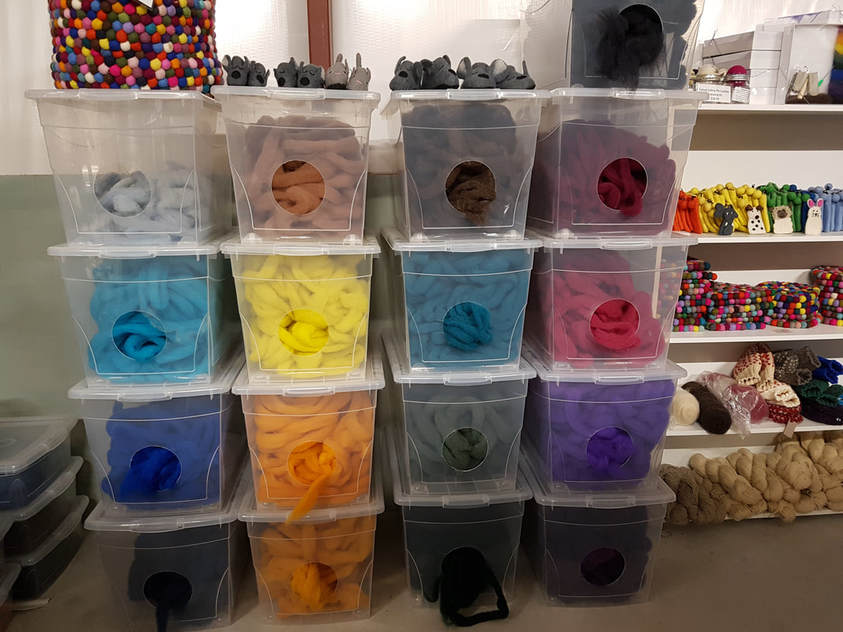I am collecting information about the wonders of wool. Today's Topic is Felting
Felting
Felting is the process of tangling fibers. It is one of the oldest fiber crafts, dating back as far as 6300 BC. Felt making predates spinning, weaving or knitting, and for centuries this non-woven fabric has provided for basic human needs, such as yurts (felt tents), rugs, hats and footwear. Wool felt has the ability to protect against heat and insulate against cold. It absorbs and holds moisture, and felt can be cut without fraying or unraveling.
Traditional felting methods require suitable animal fibers e.g. wool or alpaca, wetted with a soapy solution, and lots of mechanical action. Originally the natural grease of the raw fiber provided the necessary lubrication, but today we need to use soap, because we are working with washed fiber. Although modern friction-creating equipment and techniques, such as bubble wrap, bamboo blinds, and washing machines are now used to speed up the process, the basic principles of wet felting remain much the same as those practiced by our ancestors.
Needle Felting or Dry Felting
The felting needle was invented for industrial use; to enhance and expand the felting process so that synthetic and plant fibers could be felted. The first needle loom produced on a commercial basis came from the Bi-Water Company of Leeds, England about 1866, but not until the late 1950’s did the needle punching industry start to expand with companies utilizing fibrous waste. Needle punched non wovens were first used as spring insulators in the mattress and furniture industry and later as car carpet. The needle punching industry increasingly uses the felting needle to texture woven and knitted fabrics.
In the early 1980’s David and Eleanor Stanwood used a barbed needle from an industrial felting factory to develop needle felting as a handcraft. They taught Ayala Talpai, who continued to promote the technique. Needle felting has progressively gained popularity among hand-crafters, doll makers, bear artists, and artisans.
While wet felting remains the preferred method for hand-crafters to create firm felt and even sheets of flat felt, needle felting offers an effective means of shaping and enhancing felted surfaces and sculpturing fine detail. Initially securing areas of colour or fiber embellishments with the felting needle greatly reduces the risk of designs moving during the wet felting process. Other handcraft uses for felting needles vary widely, including strengthening yarn joins, blending felt pieces together instead of sewing seams, thickening thin areas, and mending holes in felted fabrics …or knitted socks.
Felting Needle Characteristics
Felting needles are made from carbon steel and are either 3 or 3 ½ inches long. The L-shaped hook fits into industrial equipment or in our case is the end we hold; the sharp point at the other end facilitates penetration. The “working zone” (about one third of the needle) is typically triangular in cross section, having three edges with a series of barbs cut into one or more of these edges. These barbs catch and move the fibers as the needle is repeatedly jabbed into a fiber mass. The number, spacing, depth and angle of the barbs (and the needle gauge) dictate how the needle works, and hence what it is best used for.
Barb number:
The total number of barbs per needle influences the speed of the felting process; fewer barbs allow for more precision.
Star needles have a high number of barbs, but are designed to penetrate firm felt easily, working fast and resulting in more tensile strength
Working edge:
Most felting needles are triangular with three working edges, except Star needles which are a new innovation with four edges.
You will find that needles with only one or two working edges will penetrate denser felt more easily. A needle on which the barbs are situated on one edge in a row right behind each other will move fiber reliably and can also be used sideways, parallel to the surface of the felting project.
Barb spacing and form:
Needles on which the barbs are spiraled evenly up the working blade will accomplish an even needling effect over more depth. To produce a smooth felted surface the barbs should be situated close to the tip of the needle.
Deeper barbs and more barb angle will transport more fiber but also be more aggressive.
Gauge:
The gauge (diameter) of the working zone for wool needles ranges from 32 (coarse) to 42 (super fine). In general, start your project with a coarser needle and work to a finer needle for finishing. Choose thicker needles to felt coarse fibers and finer needles when working with finer fibers. Even Merino wool will easily embrace sculptural detail. Silk can be needle felted although it is quite a challenge to retain the attractive properties of the silk, especially the luster.
Getting Started
To start needle felting you will need a handful or more of clean, carded wool and some felting needles.
Holding the hook end of a needle between thumb and forefinger, jab the working zone into the fiber mass so that all motion is parallel to the length of the needle. Placing the middle finger farther forward just above the working blade will stabilize the needle and give you more control in your work. Sideways pressure or prizing is the principle reason needles break. The two main needling techniques are:
- Stabbing - in which the working zone of the needle is fully withdrawn each time the needle is jabbed into the fiber mass.
- Jiggling – where the working zone is jabbed into the fiber mass and jiggled up and down several times before being withdrawn.
We encourage you to experiment to see which needles work best for you in different situations. While different needles have been designed for particular uses and situations, there is also a degree of personal preference involved when selecting the best needle for what you want to do. For instance, some people prefer working with longer needles when firming or hardening the felt, while other people prefer the shorter ones.
Wool4ewe has felting needles of various gauges and rovings of many colours to chooses from.


